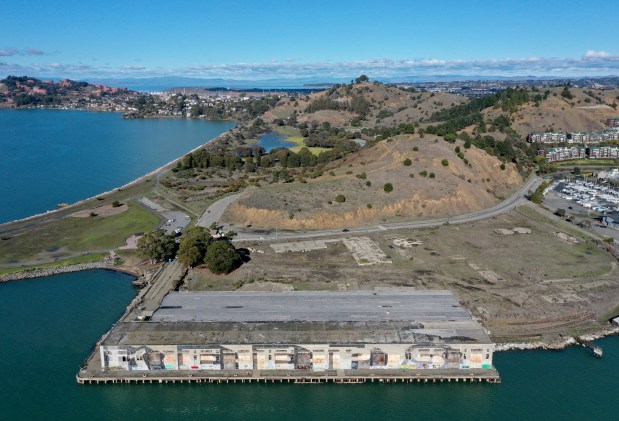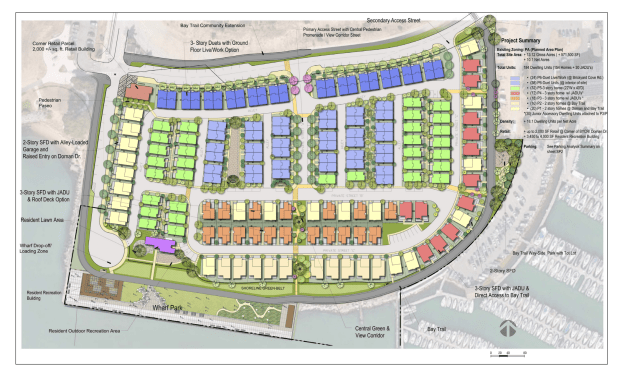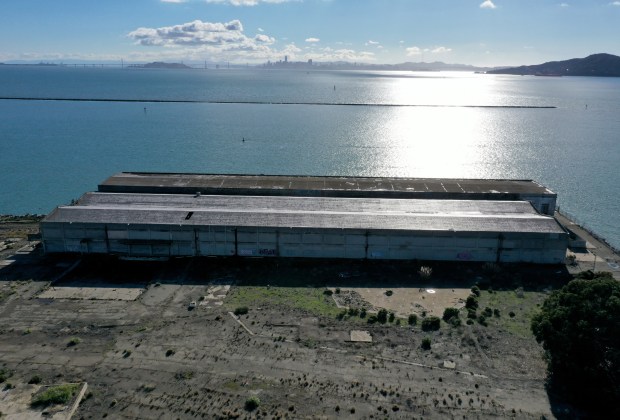|
| How many times does a prospective purchaser of City of Richmond property for development have to fail before you show them the door? Once a bright prospect, Laconia Development is now trying to push through one of the worst-designed projects in Richmond history.
The Terminal 1 site, recently rebranded by Laconia as “Latitude” was originally under contract to Toll Brothers in 2003, but they backed out when the Great Recession hit. Along came Laconia with a plan to build 316 units of housing in a now-approved and entitled design that would give every homeowner a piece of the million-dollar waterfront view. When Laconia lost the Chinese investment promised by Wuzhen Wu (“Mr. Wu”), they abandoned the approved project and transitioned to a generic and unimaginative design that would be a travesty even in Lodi or Modesto.
It turned out that Wu, who had been introduced to Laconia by the late Port Director Jim Matzorkis, Nat Bates and Eduardo Martinez, was not a wealthy financier at all but simply an EB-5 broker. Trump era anti-immigration policies, bureaucratic red tape, politics in China and fraud caused a general constriction of EB-5 funding that removed Wuzhen Wu and EB-5 as the principal source of investment in the Terminal 1 project.
A 2016 article in the San Francisco Business Times (“Chinese developer plots 330 units at prime East Bay shoreline site”) said, “The project, called Terminal One and being built by Chinese developer Terminal One LLC, includes 308 condos and 26 townhouses, as well as the development of 1.9-acre waterfront park, and preservation of the Terminal One wharf. It is one of the last shoreline properties on the San Francisco Bay available for development.”
Faced with having to resort to more conventional sources of money, Laconia pivoted to a plain vanilla design concept that had the lowest possible financial risk during the COVID-19 pandemic when the market favored single-family homes where owners did not have to share any space with potentially infected neighbors. Instead of looking to the future, Laconia is still “fighting the last war,” pushing a project whose time has passed onto Richmond.
It’s really sad to see the city attorney, who has no background in architecture and planning, push the Design Review Board and Planning Commission aside, intimidate the Community Development (Planning) staff and ramrod through such a horrible project. Unfortunately, the RPA-dominated City Council doesn’t have a clue what is going on and is falling over the cliff like lemmings.
Terminal One Single-Family Housing Development In Richmond Sent Back To The Drawing Board
https://www.eastbaytimes.com/2022/12/12/richmond-multi-million-terminal-one-single-family-housing-development-sent-back-to-the-drawing-board/
By KATIE LAUER | klauer@bayareanewsgroup.com | Bay Area News Group
PUBLISHED: December 12, 2022 at 12:06 p.m. | UPDATED: December 13, 2022 at 11:09 p.m.
RICHMOND — Dreams of transforming a dilapidated wharf, lead-contaminated warehouse and leftover slabs of industrial concrete into housing on 13.8 acres of the city’s western shoreline may be crumbling, once again.
The proposed Terminal One project is going back to the drawing board, after Walnut Creek’s Laconia Development and city staff exhausted more than seven years, a handful of now-fired architects and dozens of unproductive meetings trying to build 92 single-family detached residences, 62 duplexes and 30 junior accessory dwelling units at 1500 Dornan Drive, located near Brickyard Cove and the Miller/Knox Regional Shoreline.
This plan was already the developer’s second proposal for the site; the original project — approved back in 2014 — included 316 total units, split between 295 condos and 21 townhouses.
On Dec. 6, the Richmond City Council voted 4-1-1 to kick the 154-home project all the way back to a future 2023 agenda of the Design Review Board, which weighs in on a new development’s aesthetics, design and look. Outgoing Mayor Tom Butt voted no, and Councilmember Nathaniel Bates was absent.
The vote came after elected officials hastily approved the newest development timelines, rules and costs during the Nov. 22 City Council meeting, in order to meet state housing officials’ deadline to close the land’s sale by the end of the year and keep the project alive.
Terminal One, which was also recently re-dubbed the “Latitude Residential Project,” will also make a reprise in front of the same Planning Commission that unanimously rejected the plan, before the council has another chance to vote on the project — hopefully — within six months.
Proponents of Terminal One say it would provide a much-needed opportunity for economic development in Richmond. But once the multi-family housing plan was abandoned in April 2022, numerous opponents have blasted the plan’s lack of affordable housing and rushed approval process in the eleventh hour.
Illustrating just how poorly this project has failed to get off the ground, one of the chief complaints was the anticipated yet unspecified toll — wear on already downtrodden roads, emissions close to popular parks, impacts to residential neighbors’ peace of mind — of the estimated 25,000 dump trucks needed to haul 130,000 yards of earth to the quasi-isolated, more upscale edge of town during construction.

A former industrial plot of land is seen from this drone view along Brickyard Cove Road near Dorman Drive in Richmond, Calif., on Monday, Dec. 12, 2022. The proposed Terminal One project of 154 single-family homes over 13.8 acres of prime waterfront real estate is going back to the drawing board. (Jane Tyska/Bay Area News Group)
Jonathan Livingston, chair of the Design Review Board, likes to say Terminal One suffers from “project-itis:” a plan that gets so complicated and big, it can kill an entire idea.
Since 2014, he said the city’s planning team has tried to find a way to help Paul Menzies, Laconia’s CEO, make the plan work.
Despite unique challenges building on the Bay Area’s shoreline, Livingston said the developer blamed larger industry trends — namely skyrocketing costs of labor and construction materials, paired with a downtrodden real estate market — for creating insurmountable roadblocks to both the original plan and any suggestions for new solutions.
“I’ve been trying to be very creative with the developer to find some other way to appease the mayor, appease the new urbanists that want higher density and get him a project that he can make pencil,” Livingston explained on the phone. “I think we exhausted just about every possible scenario that he (Menzies) might be willing to entertain.”

A rendering of the amended Terminal One development in Point Richmond. Courtesy of the city of Richmond
If the deal falls apart, the city-owned property will return to Richmond and be subject to the Surplus Land Act. That would mean the entire approval process would have to restart for the site before first being offered to other government agencies and nonprofits to build affordable housing.
Livingston said he doesn’t think the City Council knows what it is doing, and suggested that residents supported one last attempt to redesign the plan, in order to avoid scrapping everything altogether and coming across as NIMBYs in the process.
He tried ringing one last warning bell against going down that road in an incendiary letter he sent to Mayor Butt last month.
“What I was trying to really say there was, ‘Guys, this dog’s not going to hunt. Just stop the bleeding now, because I know Mr. Menzies and this is what he wants to build,’ ” Livingston said, adding that the dysfunctional back-and-forth about Terminal One contributed to his decision to end his time serving on the Design Review Board in the near future. “Menzies’ up against the wall on so many levels that he’s crammed 10 pounds of (expletive) into a 5-pound bag, and it’s a horrible project because of that.”
That’s one reason why Butt is concerned the entire process has essentially “handcuffed” city officials and gutted advisory boards’ power in favor of getting something across the finish line.
“I really don’t understand why city staff, almost uniformly, is trying to ramrod this project through,” Butt said during the Dec. 6 council meeting. “I’ve never seen anything quite like it.”

A former industrial plot of land is seen from this drone view along Brickyard Cove Road near Dorman Drive in Richmond, Calif., on Monday, Dec. 12, 2022. The proposed Terminal One project of 154 single-family homes over 13.8 acres of prime waterfront real estate is going back to the drawing board. (Jane Tyska/Bay Area News Group)
As the clock ticks down on Laconia’s last-ditch attempt to earn approvals to build, two glaring, yet often unanswered, questions remain: Can the city do anything differently this time that actually helps push Terminal One across the finish line? And what kind of project could be an alternative if it fails?
Members of the Richmond Progressive Alliance, a political bloc that holds a majority on the City Council, do not know what the next steps look like, only have vague insights to share or have to stay mum on confidential discussions.
Councilmember Gayle McLaughlin would not elaborate on her hopes that the community can “come together to improve the project in a way that is satisfactory to all,” other than she’s heard that further discussions may open up new modification possibilities.
Mayor-elect Eduardo Martinez, who has spent nearly eight years as a council member and RPA majority, was more upfront about the challenges ahead.
“Poop can also be fertilizer, so it’s a matter of how you look at it,” Martinez said in an interview, referring to Livingston’s colorful description of the project.
While he said he could not share closed-door conversations about possible next steps, Martinez said it’s been disappointing and unfair for all involved that the city and a developer have spent a decade realizing a project and gotten nowhere. And even though he wasn’t sure if either the city or developer would end up pulling the plug, he added that the permits and legwork Laconia has already accomplished will help whatever comes next if Terminal One is scrapped.
“We just need to figure out a plan forward,” Martinez said. |

